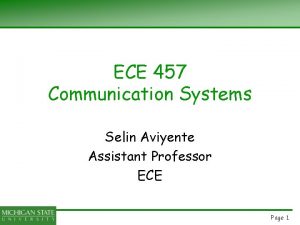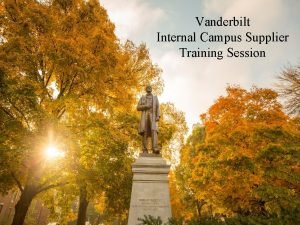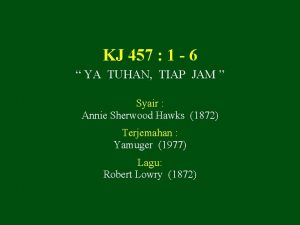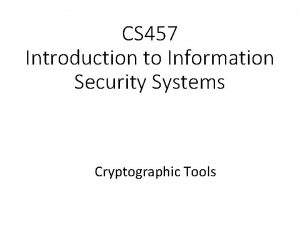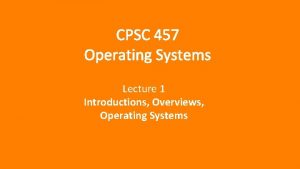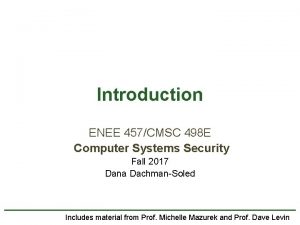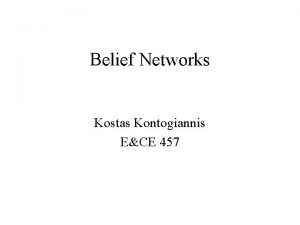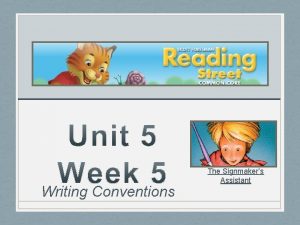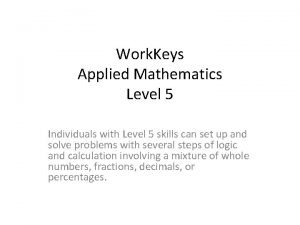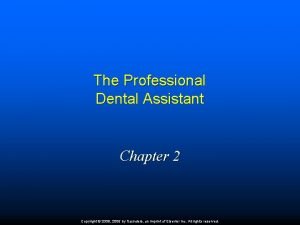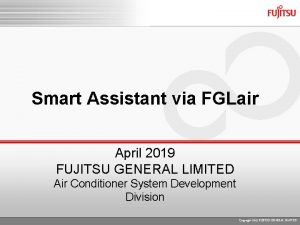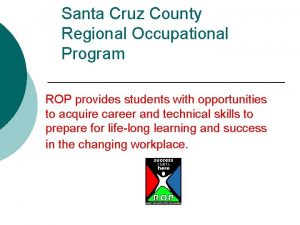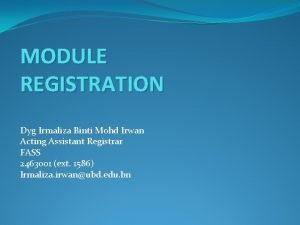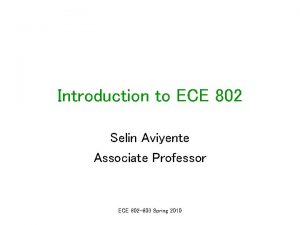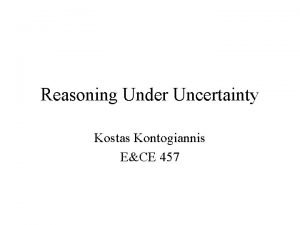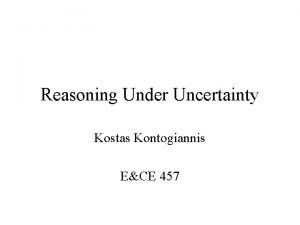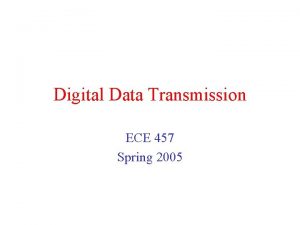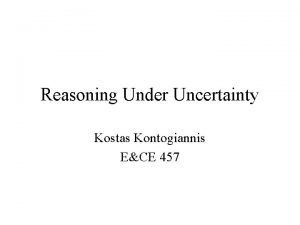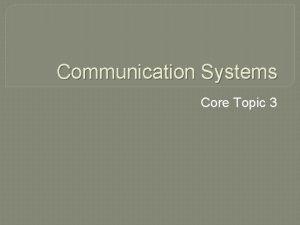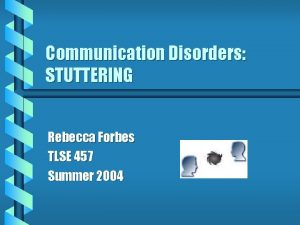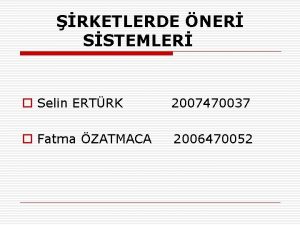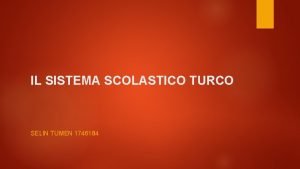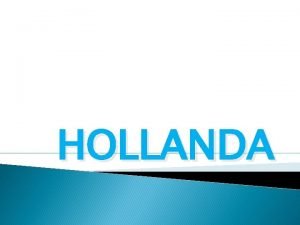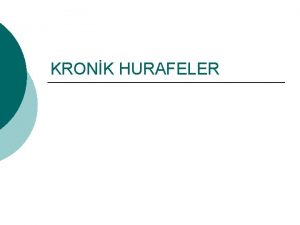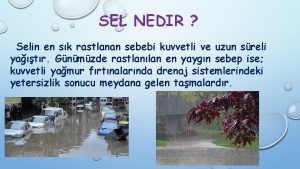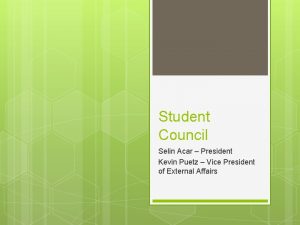ECE 457 Communication Systems Selin Aviyente Assistant Professor






















- Slides: 22

ECE 457 Communication Systems Selin Aviyente Assistant Professor ECE Page 1

Announcements • Class Web Page: http: //www. egr. msu. edu/~aviyente/ECE 457 -05. htm • Lectures: M, W, F 10: 20 -11: 10 a. m. 221 Natural Resources Building • Office Hours: W 11: 30 - 1: 00 pm, Th 9: 3011: 00 am or by e-mail appointment (2210 EB) • Textbook: Principles of Communications, Rodger E. Zimmer and William H. Tranter, John Wiley, 5 th Edition, 2002. Page 2

ECE 457 and ECE 458 • ECE 458 is designed to complement this course. • ECE 458 focuses on providing practical experience. • You will learn material in ECE 457 that is not covered in ECE 458 and vice versa. • No labs this week. • There is no lab manual this year, everything will be online. Page 3

Course Requirements • 2 Midterm Exams (50%) – February 25, April 8 in class • Final Exam, May 3 (30%) • Weekly HW assignments (10%) – Will include MATLAB assignments – HWs should be your own work (no copying!) – Assigned on Fridays due next Friday (except during exam weeks) – No late HWs will be accepted. • Quizzes (10%) – They will be unannounced. – Based on HW questions (10 -15 minutes long) Page 4

Policies • Cheating in any form will not be tolerated. This includes copying HWs, cheating on exams and quizzes. • You are allowed to discuss the HW questions with your friends, and me. • However, you have to write up the homework on your own. • There is no make-up for missed quizzes. • If you have an excuse for not being in class, please e-mail me before class. Page 5

Honors Option • Honor credit option is available • Typical projects have either a software/hardware implementation component and an oral presentation. • Past projects include: – Building a FM transmitter – MATLAB simulation of digital modulation systems. • Please feel free to come and talk to me about your ideas for a possible project. Page 6

Tentative Syllabus • Overview of Communication Systems • Review of Signal Analysis (ECE 366) • Deterministic Modulation – Linear (DSB, AM, SSB, VSB) – Angle Modulation (FM, PM) • Review of Probability and Random Processes • Noise in Modulation Systems • Digital Modulation (as time permits) Page 7

Communication Systems • A communication system conveys information from its source to a destination. • Examples: – – – Telephone TV Radio Cell phone PDA Satellite Page 8

Communication Systems • A communication system is composed of the following: Source Input Transducer Transmitter Channel Receiver Output Transducer Page 9

Input Transducer • Source: Analog or digital • Example: Speech, music, written text • Input Transducer: Converts the message produced by a source to a form suitable for the communication system. • Example: Speech waves Microphone Voltage Page 10

Transmitter • Couple the message to the channel • Operations: Amplification, Modulation • Modulation encodes message into amplitude, phase or frequency of carrier signal (AM, PM, FM) • Advantages: – Reduce noise and interference – Multiplexing – Channel Assignment • Examples: TV station, radio station, web server Page 11

Channel • Physical medium that does the transmission • Examples: Air, wires, coaxial cable, radio wave, laser beam, fiber optic cable • Every channel introduces some amount of distortion, noise and interference Page 12

Receiver • Extracts message from the received signal • Operations: Amplification, Demodulation, Filtering • Goal: The receiver output is a scaled, possibly delayed version of the message signal (ideal transmission) • Examples: TV set, radio, web client Page 13

Output Transducer • Converts electrical signal into the form desired by the system • Examples: Loudspeakers, PC Page 14

Capacity of a Channel • The most important question for a communication channel is the maximum rate at which it can transfer information. • There is a theoretical maximum rate at which information passes error free over the channel, called the channel capacity C. • The famous Hartley-Shannon Law states that the channel capacity C is given by: C=B*log(1+(S/N)) b/s where B is the bandwidth, S/N is the signal-to-noise ratio. Page 15

Fundamental Limitations • Therefore, there are two factors that determine the capacity of a channel: – Bandwidth – Noise Page 16

Frequency Spectrum • Most precious resource in communications is “frequency spectrum” • The “frequency spectrum” has to be shared by a large number of users and applications: • AM Radio, FM Radio, TV, cellular telephony, wireless local-area-networks, satellite, air traffic control Page 17

Frequency Spectrum • The frequency spectrum has to be managed for a particular physical medium • The spectrum for “over-the-air” communications is allocated by international communications organization • International Telecommunications Union (ITU) • Federal Communications Commission (FCC) designates and licenses frequency bands in the US. Page 18

Frequency Spectrum Example Application AM Radio TV (Channels 26) FM Radio TV (Channels 713) Cellular mobile radio Frequency Band 0. 54 -1. 6 MHz 54 -88 MHz 88 -108 MHz 174 -216 MHz 806 -901 MHz Page 19

Noise • Internal and External Noise • Internal Noise: Generated by components within a communication system (thermal noise) • External Noise: – Atmospheric noise (electrical discharges) – Man-made noise (ignition noise) – Interference (multiple transmission paths) Page 20

History of Communications Year Event 1838 Telegraphy (Morse) Telephone (Bell) 1876 1902 1933 Radio transmission (Marconi) FM radio 1936 TV broadcasting 1953 Color TV Page 21

History of Communications Year Event 1962 1972 Satellite communication Cellular phone 1985 Fax machines 1990 s GPS, HDTV, handheld computers Page 22
 Ece458
Ece458 Karl selin
Karl selin Hydroline liikevaihto
Hydroline liikevaihto Promotion from associate professor to professor
Promotion from associate professor to professor Cuhk assistant professor salary
Cuhk assistant professor salary Vumc eprocurement
Vumc eprocurement Kj 457
Kj 457 Cs 457
Cs 457 Cpsc457
Cpsc457 Region 10 rams 457 plan
Region 10 rams 457 plan Enee457
Enee457 Artaxerxes decree 457
Artaxerxes decree 457 Cpsc 457
Cpsc 457 Decision support systems and intelligent systems
Decision support systems and intelligent systems Engineering elegant systems: theory of systems engineering
Engineering elegant systems: theory of systems engineering Embedded systems vs cyber physical systems
Embedded systems vs cyber physical systems Engineering elegant systems: theory of systems engineering
Engineering elegant systems: theory of systems engineering The signmaker's assistant quiz
The signmaker's assistant quiz As a laboratory assistant you measure chemicals
As a laboratory assistant you measure chemicals Chapter 2 the professional dental assistant
Chapter 2 the professional dental assistant Fglair home assistant
Fglair home assistant Medical assistant rop
Medical assistant rop Assistant registrar ubd
Assistant registrar ubd
